


TINTIN, in Dutch known as KUIFJE, can only be described as one of the very top European strips and has to be among the greatest strips in the world. Even if Amazon feels they're only fit for children between 4-8, this is saying something. So don't get me wrong: it is not to put Hergé down that I built this page, but to show that you can always find mistakes in the best of work; and to show how times do change. Hergé had an enormous influence on European strip artists like Joost Swarte. I have always enormously enjoyed these strips, even if it's really nothing but James Bond as a boy scout; which means, no dames on the set. Maybe that explains why they are so much more palatable (much as I like dames myself, join the club).
TINTIN is often called a French strip; actually, it's Belgian. I have the Kuifje books in Dutch and, mostly, use the Dutch covers and character names. Other people have done hard work here, only to have their links timing out. Then there's the (also French) Tintin Cyber Catalogue—at least, there used to be. Unsurprisingly, there is plenty of more solid info available than I have to present. Try the Tintin Web Ring. (I tried to get on this ring, but they never even took the trouble to reply. Too much cussing and nudity on this site, I guess. Same for the Lucky Luke ring.) Unfortunately, all these links definitely have a habit of dying in your hands. Don't ya know it.
Hergé turned out enormous volumes of work which were translated and published all over the world. Besides the Kuifje titles he published much more; there's a list at the bottom of this page. All his stuff is very well done if, naturally, some is better than other. What else is new? Well, Hergé kept re-designing his strips, for example by changing old-fashioned planes into jets for a new edition, and other things as well. The funny things my sick mind is concerned with here are what he never bothered to change.
And now that I have got all this off my chest, I can go back to reading the books without being bugged by
what after all are mostly pretty minor, details.
One more thing: All this stuff is Copyright by Hergé and don't you forget it.
Some of the following cover pictures are linked to a page with more info; the titles are linked to Amazon.
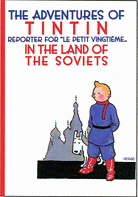
| IN THE LAND OF THE SOVIETS The first KUIFJE "album". Only, when it first appeared somewhere around 1970, it was a rip-off and publisher Casterman even denied it was authentic. But if you read it, you got convinced it was authentic. And finally, after all these years, it appeared with the Casterman imprint. Replacing the even more politically incorrect TINTIN IN CONGO. After all, there is no Soviet Union anymore so who's to complain? |
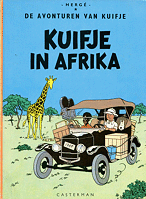
| IN AFRICA  

 Not the first KUIFJE "album", but the first one in the format Hergé would stick to. The book is so politically incorrect by now, it's a miracle there have been no protest riots in the streets. Is what you would think. But here in Curaçao, where some 90% of the population is "negro", in Hergé's terminology, I can't remember anybody ever taking exception to his stereotyped characterizations. For what it's worth, my opinion is that nobody, black, blue or white, can relate to this weird but at the time popular way of drawing blacks and recognize himself in there. It's just too far out and altogether removed from reality. Click on the cover picture and I'll show you what I mean. It has now disappeared from the back-cover of the Tintin albums. |
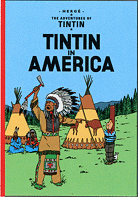 | IN AMERICA  

 Some real good laughs, if unintentional, can be had here by Americans, and these days by most people all over the world. It shows how Europeans looked at the U.S.A. not so long ago. Kuifje even narrowly escapes being burned at the stake by Indians; as if those things were still bound to happen around 1940. |
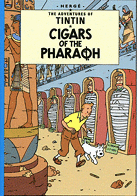 | CIGARS OF THE PHARAOH  

 Much less primitive than its two predecessors; as a matter of fact quite sophisticated. Good plotting, solid characters. Drawing style, too, is technically much better. Part 1 of 2 volumes. Dumb-ass detectives Jansen and Janssen, Dupond & Dupont (dese guyses love disguises) are introduced here and are kept in for future appearances. |
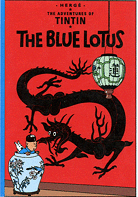 | THE BLUE LOTUS  

 Part II. This one gets really funny. Racism again raises its ugly head. To get your bellyful of laughs, click on picture. |
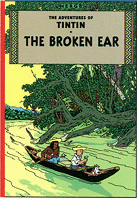 | BROKEN EAR  

 One of my favorites. If only because there's a parrot in there that keeps repeating a knife throwing artist's remark after him: Caramba! Missed again! An expression I have had many occasions to use as a photographer; not to worry about that. |
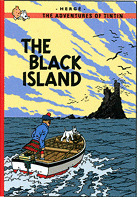 | THE BLACK ISLAND  

Good and solid. There's a King Kong type of gorilla in it, only real-life sized. |
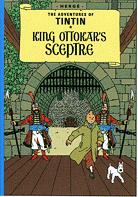 | KING OTTOKAR'S SCEPTRE  

 Clearly shows Hergé's attitude towards monarchy. It's all about a dirty plot in a Balkan country to rob the 'rightful' king of his throne. Of course, this must be prevented. (See also Charlie Chaplin's A King in New York on this sort of idealism). What can you say? But very entertaining indeed. |
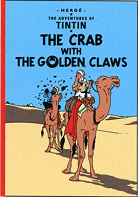 | THE CRAB WITH THE GOLDEN CLAWS  

 The first book with Captain Haddock. Many Kuifje villains keep making their appearance under new identities, but they are still obviously the same characters; often even looking alike. But Haddock is such a strong vaudeville comedian (and I'm sure Hergé must have seen this right away) that he keeps coming back. On Haddock there's more to say, click picture link. |
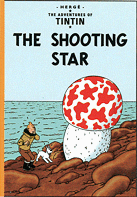 | SHOOTING STAR  

Essentially science fiction. OK. The first Kuifje I remember reading. Look, I am not making a habit of discussing plot improbabilities or anything like that or this page would never get finished. |
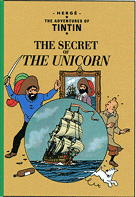 | SECRET OF THE UNICORN  

 Really fine. Again, part 1 of 2. This is where, I feel, Hergé is reaching the top if his career. |
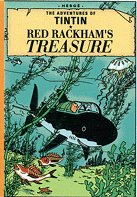 | RED RACKHAM'S TREASURE  

 Part 2. Even better! Intro of Professor Girasol, Zonnebloem, Calculus, whatever you want to call him. A real schlemil and all absent-minded professors you've ever seen rolled into one. Too bad that here superstition starts working its way into Hergé's work. Clink the lick. Of course, you can't go far wrong when you lift so much out of R.L. Stevenson's Treasure Island. |
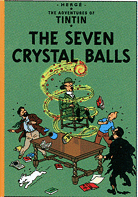 | SEVEN CRYSTAL BALLS  

 Part 1. Really fine with a good sense of mystery, and the superstition is still easy to take. Just go along for the ride and enjoy the trip. |
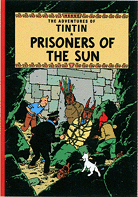 | PRISONERS OF THE SUN  
 Part 2. I cannot restrain myself here and will remark that it's inconceivable that Kuifje would be saved from being killed by Incas by the occurrence of a solar eclipse they didn't expect. The Incas didn't figure on this? Cummon, gimme a break. Or so I wrote a while back. Well, as happens more often than I care for, I was wrong. It was the Mayas who wouldn't have been fooled—the Incas didn't know the first thing about astronomy. Brings up the question: Did they, then, worship the sun as Hergé would have us believe? It's all very moot. |
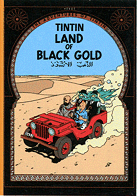 | THE LAND OF THE BLACK GOLD  

 Very funny! What more do I have to tell you? Here Hergé has a serious plot problem ( How do I get Haddock on the scene to save Tintin in the nick of time?) but he works his way out of it very cleverly: He doesn't even try to answer the question and turns it into a joke. |
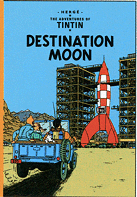 | DESTINATION MOON  

 Part 1 of 2; published when I had just made it to High School. That's in the early 1950s, if you want to know. Very impressive (I don't mean the fact that I made it to that crummy school or even that I finished it). Don't be put off by things we know much better now; it's still pretty accurate and, to paraphrase Harvey Kurtzman (The Katch and Hammer Kids), without the monkey business there is no comic strip. Much better than the average SciFi novel anyway. Yeah, that often is not saying so much. |
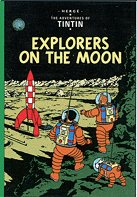 | EXPLORERS ON THE MOON  

 Part 2 of 1. That can't be right... Anyway, they arrive on the moon and get back home safely. But even when I read it first I couldn't imagine how they could have reached the moon with two stowaways on board—and pretty hefty ones, too. Hope I didn't ruin the suspense for you, but the fact there are more titles coming is a dead giveaway, after all. Also, the interior of the rocket ship is even roomier than Jules Verne's Nautilus. And by that proverbial way, Hergé should be ashamed of himself, always insisting on copyright claims. His decors in this book are shamelessly ripped off from George Pal's Destination Moon; the movie that probably inspired him in the first place. |
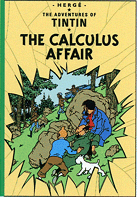 | THE CALCULUS AFFAIR  

 That's some title to attract strip crazed kids! The book where prima donna Bianca Castafiore is introduced. Now that I've typed that down, a great surprise. I had always figured she was in the strips practically all the time, but it turns out she's only in four of them. With a vengeance: A rather impressive personality. (Hergé was an opera fan, specifically Verdi). Adolf Hitler is in there as well, but not everybody has found him. You want to brag to your friends (such as they are) with your trivia knowledge, click on the link and I'll help you out. More trivia on that same page on castle Molensloot/Muizenmeul/Moulinsart. Or whatever it's called in your language. Eureka! I found the original! Triviata galore! |
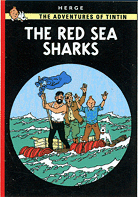 | THE RED SEA SHARKS  

 If you have dutifully clicked on my preceding links, you will have to agree with me that Hergé was a racist. But he didn't want to be one! More power to him. Try this one and I'll offer proof. Here, I feel, the quality of the strips starts to decline. A pity, but what do you want? I myself recently made a translation of something that was godawful. Not that I could really help it, but neither could Hergé, of course. Still a fine work (the strip, not my translation). |
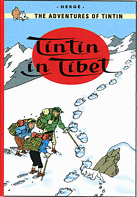 | IN TIBET  

Hmmm... This one, as far as superstition is concerned, is definitely over the edge. Yetis yet, for starters, forsooth. Click the pic and have a good laugh, if not intended so by Hergé. |
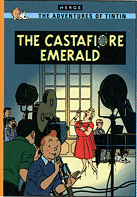 | THE CASTAFIORE EMERALD  

 A healthy bounce back to reason and fun! A plot that might well have turned out to revolve about occult forces, but he fools you all right. Also very sympathetic in, for a welcome change, its non-bigoted treatment of gypsies. I love this one. |
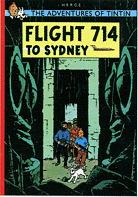 | FLIGHT 714  
 Sorry, my friend Hergé here went too far. I got more laughs from what he seems to believe in than from the gags. Still, that's something. Actually, it's an awesome lot! Click and shake your head; or waggle your belly-button to choice. |
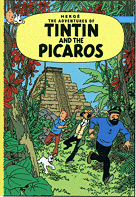 | TINTIN AND THE PICARO'S  

 The last album Hergé completed. Don't care much for it. But in here Jansen and Janssens, or whatever they're called in various languages, do have their great moment which really makes it worth your while. Also Bianca Castafiore is, for once, not ridiculous but even dignified. And Zonnebloem, or Girasol, or Calculus, or Chicken Feed—who knows or even cares? so much for trivia—tries to cure Haddock of his alcoholism. About time, too. But does he succeed? Buy the strip and find out. What I really like about this one is the come-back of Alcazar from Broken Ear; only, he's better shaven here. |
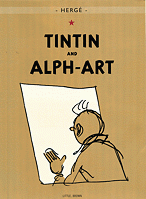 | TINTIN AND ALPH-ART Hergé's last album which he never completed. For the die-hard fans. It's in very crude form and if you can learn anything from it, is that his strips were much more dependent from the drawings than from the plots. Wodehouse, it ain't. |
I devoutly wish to gott that the publishers would bind those books so they wouldn't fall apart right away.
There are more titles and also movies, some of them animated; not all are available in English.
Cigars of the Pharaoh (1991)



Animated, Color, NTSC
Secret of the Unicorn (1991)


Animated, Color, NTSC; directed by Stéphane Bernasconi (Part 1)
From Hergé's archives:
The Adventures of Totor
Tintin in the Soviet Union
Movies, also available as strip albums:
Kuifje en het Haaienmeer
Kuifje en het Geheim van het Gulden Vlies
Kuifje en de Blauwe Sinaasappels
De Avonturen van Jo, Suus en Jokko:
Het Testament van Mr. Pump
Bestemming New York
De 'Manitoba' antwoordt niet meer
De Uitbarsting van de Karamako
De Navajavallei
Leo en Lea bij de Lapino's
De Guitenstreken van Kwik en Flupke (Vol. 1-2-3-4-5-6)
JONGE REPORTER
AAN DE ROL
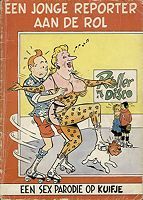
[Tintin on the Spree]




SEARCH this site or the Web

copyright notice
all Tintin material © by Hergé
all other material on this site, except where noted
copyright © by harrie verstappen , curaçao
reproduction in any form for any purpose is prohibited
without prior consent in writing